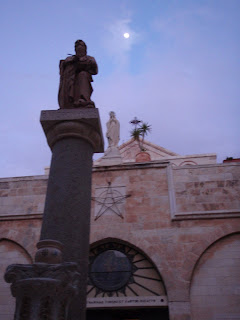While the Israeli calendar marks March 14th as Independence day, a day of celebration and rejoicing, Palestinians have named March 15th Al Nakbah, the “Catastrophe,” a day to reflect on their exile from homes and homeland. Before the British pulled out of Palestine and the Israeli state was created on March 14th 1948, Muslim and Christian Palestinians lived peacefully, side by side with their Jewish neighbors. Seemingly in an instant, Everything changed for the Palestinian people, with the declaration of independence for Israel came the destruction of the Palestinian dream of statehood.
Palestinians all over the newly christened state of Israel were run out of their homes by advancing Israeli troops and forced to seek shelter in towns within what is today the West Bank and Gaza. The stories of these refugees all differ slightly, but an overwhelming majority were told by the newly formed United Nations (by Resolution 194) that they would be able to return to their homes in a matter of days. Families left radios on, food out on the counters, only bringing enough clothes for a short journey. Because The UN was only expecting a brief refugee situation, they simply provided Tents and basic camping equipment for the swiftly overfilling refugee camps dotting the West Bank.
Most refugees lived in these meager conditions for two years. By 1950, it became clear that the refugee situation was not going to disappear as Israel became increasingly entrenched within it's newly established borders. As a result of the War in 1948, What is now the West Bank was taken over by Jordan. Control of the Gaza Strip went to the Egyptians. Conditions for the refugees continued to deteriorate as tent villages became overcrowded Refugee camps. As time wore on, populations in the camps grew but the area of the camps could not. Cement and stone buildings eventually replaced tents but these were never adequate to support such a massive, continually growing, displaced population.
The Palestinian refugee population today numbers above 4.7 million, with refugees predominantly living in Lebanon, Syria, Jordan, The West Bank and Gaza, but with groups in many South American Countries and all over the world. The right for Palestinians to return to their previous towns and villages, promised by UN Res. 194, has never been honored, a fact that more than Palestinian refugees have not forgotten. Refugees and their descendents still wear their original house keys around their necks, a constant reminder of their resolve to return.
With tensions rising in the middle east, threats of war came from all sides of Israel. Lebanon, Syria, Jordan, and Egypt all began to ramp up for war with Israel. By 1967, this violent rhetoric had reached a tipping point and Israel launched it's fighter planes in a preemptive attack on it's neighboring countries. The Six Day War nearly tripled Israel's land holdings and most importantly, Gaza and the West Bank were now again part of Israel. As a result, vast numbers of Palestinians were now contained within the state of Israel. The borders of Israel previous to the Six Day War are documented by the Green Line and these borders are what many Palestinians consider as the dividing line between Israel and Palestine. Palestine as a result of this war, became an occupied territory.
The Israeli occupation of Palestine brought with it a slew of new problems for the Palestinian people. With no recognized representation and a police state surrounding them, Palestinian grievances were on the rise. The first Intifada, a largely nonviolent movement of protests and demonstrations against the Israeli occupation began in December 1987 and continued for six years as a result of the poor treatment of the Palestinian people. This conflict turned bloody when Israeli Defense Forces (IDF) retaliated to these demonstrations with deadly force, which led to increasingly violent activities on both sides. By the end of the first Intifada, over a thousand Palestinians had been killed by IDF soldiers with over 120,000 arrested over the course of the 6 year conflict. The Intifada was the first time that the Palestinian people rose, in a grassroots fashion, against the Israeli occupation without the support of other Arab nations. This is significant because it showed the Palestinian resolve and determined their identity. The Oslo Peace Accords in 1996 ended this first Intifada, and as a result, Israel was forced to acknowledge the Palestinian Liberation Organization (PLO) as the legitimate representative organization for the Palestinian people. This was also the first time that the Palestinians garnered international attention on the subject of human rights abuses in the occupied territories. Because the conflict was largely through nonviolent protest, the PLO had much more support than if violent means had been used. The Palestinian National Authority was also formed through the Oslo Peace Accords. Establishing Palestinian governmental control over certain areas of the West Bank.
The West Bank was split up by Oslo into areas A, B, and C. Area A is under direct Palestinian control, B is under joint control and C is controlled by the Israeli government. It was originally understood that this would eventually transfer control of the Occupied Territories to the Palestinians with area B slowly transferring to A, and C to B, then finally to area A. This process has never occurred. Instead, Israeli backed “settlements” continue to be built on confiscated Palestinian land in Area C to this day. This action has been deemed illegal by the UN, and is one of the most significant roadblocks for the peace process.











